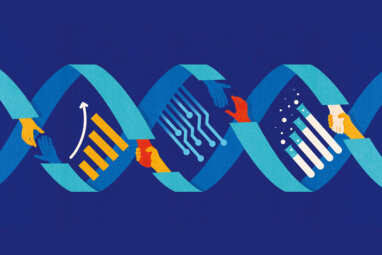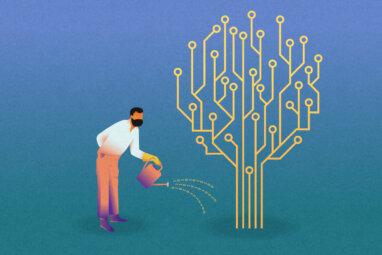Closing the Innovation Achievement Gap
Recent research sheds light on what separates innovation leaders from laggards and the key shifts executives must make to move into the leader category.
Topics
We’re living in an age of digital disruption, and many executives are in a quandary. They understand that their businesses must embrace innovation to remain competitive, yet many find that their own technology-led transformation projects are failing to deliver the expected value. As a result, many companies face an innovation achievement gap, which marks the difference between the potential value of technology investments and the actual value realized by companies.
At Accenture, we’ve conducted research to examine this gap, and our latest Future Systems study highlights the scale of this challenge for organizations. The results shed light on what separates the companies that are innovation leaders from the innovation laggards and the key shifts that executives must make to move their businesses into the leader category.
Technology Leaders Outpace Laggards in Revenue Growth
When we compared businesses’ levels of technology adoption, technology penetration, and organizational change, we categorized the top 10% as leaders. They’re enjoying levels of revenue growth that are double those of laggard businesses — those that occupy the bottom 25% in terms of adoption, penetration, and organizational change. Unless these laggard organizations change tack, they could end up losing around 46% of their potential annual revenue by 2023.
What makes a company an innovation leader? To a great extent, it’s a matter of mindset. These enterprises think in terms of systems rather than stand-alone technologies. Each of them is actively creating its strategic path to becoming a future system, a term we use to describe a coming technology paradigm that will be defined by three key characteristics:
- They are boundaryless. Future systems are based in the cloud and able to take advantage of the blurring of boundaries between the digital world (data, infrastructure, and applications) and the physical world (humans and machines), and even between competing organizations.
- They are adaptable. Future systems use automation and AI technologies to learn, improve, and scale by themselves, thus eliminating the friction that hinders business growth and helping workers make better decisions, faster.
- They are radically human. Future systems will interact seamlessly with people on human terms using AI and natural interfaces. By bringing elegant simplicity to every human-machine interaction, they will create a new competitive frontier for customer experience and make workers more efficient and effective.
Thinking Like the Top 10%
Across the board, leaders are outpacing laggards in the adoption of foundational technologies. But as we have uncovered, adoption alone isn’t enough to unlock optimum value. So, what is it about the leading innovation organizations that make them so successful? We have identified five key behaviors that define a company’s status as a leader. By adopting these behaviors, lagging companies can take steps to catch up to competitors and bridge their own innovation achievement gaps.
- Leaders adopt technology that makes them fast and adaptable. According to our research, 83% of innovation leaders agree that it’s important to decouple data from legacy infrastructure, compared with only 37% of innovation laggards. Leaders’ adoption of critical technologies that enable decoupling outpaces that of laggards by a massive margin: 97% versus 30%. By decoupling data from infrastructure, and using flexible architectures such as microservices, these top companies are able to respond quickly to demand and can scale with ease.
- Leaders are grounded in cloud computing. Ninety-five percent of leaders have adopted sophisticated cloud services, like serverless computing, compared with 30% of laggards. This is important because the cloud is the best way to consume other vital technologies such as AI and analytics.
- Leaders see data as both asset and liability. Leaders understand that real-time data is essential to business transformation — but that poor data will not get them very far. Only 40% of laggards ensure data quality, compared with 90% of leaders. And whereas just 54% of trailing companies continue to enrich their data, 90% of leaders are doing so. That means top companies have more trust in their data, and they are also working systematically to ensure that this trust will be hardwired into future AI deployments.
- Leaders manage their technology investments strategically across the enterprise. They have clear visibility into companywide technology investments and are much more likely to track factors such as ROI than are laggards. Leaders look to break down barriers within their organizations and establish innovation centers that create pipelines for further innovation transfer.
- Leaders find creative ways to nurture talent. They understand that investing in talent is the best way to advance future systems. Without extensive retraining in new technologies, employees won’t be able to work with the expansive, flexible, human-centric systems necessary for success. Leaders are outpacing laggards in terms of training: They use experiential learning at three times the rate of laggards (73% versus 24%), and they launch apprenticeship programs at more than double the rate (79% versus 36%).
Closing the innovation achievement gap will require significant cultural change within businesses. Companies that wait to tackle this challenge will find it increasingly difficult to catch up as new technologies proliferate and the pace of business accelerates. The good news is that every company can emulate the leaders’ mindsets and methods to get the outcomes they want from their technology investments.









